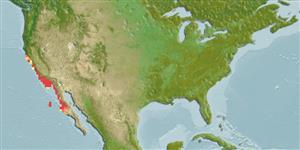Environment: milieu / climate zone / depth range / distribution range
Écologie
marin démersal; profondeur 0 - 229 m (Ref. 96339). Subtropical; 40°N - 26°N, 124°W - 112°W
Eastern Pacific: Bodega Bay in northern California, USA to central Baja California, Mexico.
Taille / Poids / Âge
Maturity: Lm ? range ? - ? cm
Max length : 29.0 cm TL mâle / non sexé; (Ref. 2850)
Adults inhabit inshore and offshore waters (Ref. 2850). From surface to 229 m (Ref. 96339). Viviparous, female carries the developing young (Ref. 205). Seldom caught by fishers (Ref. 2850).
Life cycle and mating behavior
Maturities | Reproduction | Spawnings | Egg(s) | Fecundities | Larves
Viviparous, female carries the developing young (Ref. 205).
Eschmeyer, W.N., E.S. Herald and H. Hammann, 1983. A field guide to Pacific coast fishes of North America. Boston (MA, USA): Houghton Mifflin Company. xii+336 p. (Ref. 2850)
Statut dans la liste rouge de l'IUCN (Ref. 130435)
Menace pour l'homme
Harmless
Utilisations par l'homme
Pêcheries: commercial
Outils
Articles particuliers
Télécharger en XML
Sources Internet
Estimates based on models
Preferred temperature (Ref.
123201): 9.5 - 14.8, mean 11.3 °C (based on 10 cells).
Phylogenetic diversity index (Ref.
82804): PD
50 = 0.7500 [Uniqueness, from 0.5 = low to 2.0 = high].
Bayesian length-weight: a=0.01905 (0.00831 - 0.04372), b=2.97 (2.77 - 3.17), in cm total length, based on LWR estimates for this (Sub)family-body shape (Ref.
93245).
Niveau trophique (Ref.
69278): 3.3 ±0.5 se; based on size and trophs of closest relatives
Résilience (Ref.
120179): Milieu, temps minimum de doublement de population : 1,4 à 4,4 années (Preliminary K or Fecundity.).
Fishing Vulnerability (Ref.
59153): Low vulnerability (19 of 100).
Nutrients (Ref.
124155): Calcium = 87.7 [47.0, 153.6] mg/100g; Iron = 1.04 [0.60, 1.79] mg/100g; Protein = 18.4 [17.3, 19.4] %; Omega3 = 0.31 [0.19, 0.51] g/100g; Selenium = 30.1 [16.2, 58.9] μg/100g; VitaminA = 10.8 [3.2, 35.4] μg/100g; Zinc = 0.749 [0.528, 1.083] mg/100g (wet weight);
